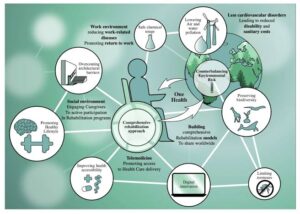Back to: MICROBIOLOGY 100 LEVEL
Welcome to class!
Hello brilliant one! It’s always so exciting to have you here. Your hunger for knowledge shines brighter than a Lagos sunrise! Today, we’ll be learning about something that shows just how powerful and complex microorganisms are—their roles in disease and the environment. Some are troublemakers, while others are lifesavers. Let’s understand how they shape the world around us—and even inside us.
Roles In Disease And Environment
Microorganisms as Causes of Disease (Pathogenic Roles)
Not all microorganisms are friendly. Some cause infections and diseases in humans, animals, and even plants. These harmful ones are called pathogens. They invade living organisms, multiply, and interfere with normal body functions.
Examples of Diseases Caused by Microorganisms:
Bacteria:
Mycobacterium tuberculosis causes tuberculosis

Vibrio cholerae causes cholera
Streptococcus pyogenes causes sore throat
Viruses:
HIV causes AIDS
Influenza virus causes the flu
SARS-CoV-2 causes COVID-19
Fungi:
Candida albicans causes yeast infections
Aspergillus species can cause lung infections
Protozoa:
Plasmodium falciparum causes malaria
Entamoeba histolytica causes dysentery
How Microbes Cause Disease:
Entry: Through the mouth, nose, skin, or wounds
Multiplication: They grow inside the host’s body
Toxin Production: Some release harmful substances that damage tissues
Spreading: Many are contagious and pass from person to person
Microorganisms in the Environment (Beneficial Roles)
Surprisingly, most microorganisms are not harmful. In fact, the environment would not survive without them. They perform many important tasks that support life on Earth.
Helpful Roles of Microorganisms:
Decomposition:
Microorganisms like bacteria and fungi break down dead plants and animals, recycling nutrients back into the soil. Without them, garbage would pile up everywhere!
Nitrogen Fixation:
Some bacteria like Rhizobium live in the roots of legumes (like beans and groundnuts) and help convert nitrogen from the air into a form plants can use to grow.
Food Production:
Bacteria help make yoghurt, cheese, and fermented foods like ogi (pap).
Yeast is used in bread making and brewing drinks like palm wine.
Bioremediation:
Microbes help clean up oil spills and toxic waste from the environment. They eat up the harmful chemicals and purify the land and water.
Soil Fertility:
By breaking down organic matter, microbes enrich the soil and help crops grow better.

Medicine Production:
Penicillium fungus produces penicillin, the first antibiotic
Bacteria are used to produce insulin and vaccine.
Imagine microorganisms as members of a community. Some are robbers (pathogens), but many are farmers, cleaners, and doctors—working every day to keep the environment balanced and healthy.
Summary
- Microorganisms can cause diseases like tuberculosis, malaria, HIV, and cholera.
- Pathogens enter the body, multiply, and may produce toxins.
- Most microbes are helpful: they decompose waste, fix nitrogen, produce food and medicine, and clean the environment.
- Microorganisms play both destructive and life-saving roles in nature.
Evaluation
- What is a pathogen?
- Mention two diseases caused by viruses and two caused by bacteria.
- How do microorganisms help in farming?
- What role do microbes play in food production?
- Explain the meaning of bioremediation.
By understanding both the good and the bad sides of microorganisms, you become wiser and more prepared for real-world science. Stay curious and keep rising with Afrilearn—we believe in you and your bright future!
